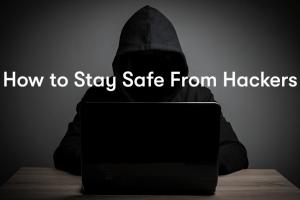Stay Safe From Hackers: Essential Strategies for Protecting Your Accounts & Devices

-
Quick Links:
- Introduction
- Understanding Hackers
- Common Attack Vectors
- Importance of Password Security
- Two-Factor Authentication
- Device Security
- Protecting Your Internet Connection
- Recognizing Phishing Attempts
- The Role of Antivirus Software
- Data Backup and Recovery
- Case Studies
- Expert Insights
- Step-by-Step Guide to Enhanced Security
- Conclusion
- FAQs
Introduction
The digital landscape is an ever-evolving battleground where hackers continuously look for vulnerabilities to exploit. With the increase in online activities, protecting your accounts and devices has never been more critical. In this comprehensive guide, we’ll explore effective strategies for safeguarding your digital life against these threats.
Understanding Hackers
Hackers can be categorized into various types based on their motives and methods. Understanding these categories can help you better protect yourself:
- White Hat Hackers: Ethical hackers who help organizations secure their systems.
- Black Hat Hackers: Criminal hackers who exploit vulnerabilities for personal gain.
- Gray Hat Hackers: Operate in a morally ambiguous space, sometimes breaking laws to expose vulnerabilities.
Common Attack Vectors
Hackers employ various methods to infiltrate systems, including:
- Phishing: Deceptive emails or messages designed to trick users into revealing sensitive information.
- Malware: Malicious software that can damage or gain unauthorized access to systems.
- Ransomware: A form of malware that locks users out of their data until a ransom is paid.
- Social Engineering: Manipulating individuals into divulging confidential information.
Importance of Password Security
A strong password is your first line of defense. Here are essential practices:
- Use long, complex passwords with a mix of letters, numbers, and symbols.
- Avoid using personal information that can be easily guessed.
- Change passwords regularly and never reuse old passwords.
Two-Factor Authentication
Two-factor authentication (2FA) adds an extra layer of security by requiring a second form of verification. This can include:
- Text message codes
- Email confirmations
- Authentication apps such as Google Authenticator or Authy
Device Security
Securing your devices is crucial. Here’s how:
- Keep your operating system and software updated.
- Use a reputable antivirus program and perform regular scans.
- Enable firewalls to block unauthorized access.
Protecting Your Internet Connection
Ensure your internet connection is secure:
- Use a secure Wi-Fi password and change it periodically.
- Disable guest networks unless absolutely necessary.
- Consider using a VPN for added privacy and security.
Recognizing Phishing Attempts
Stay vigilant against phishing attacks by looking for:
- Unusual email addresses or domains
- Spelling and grammatical errors in messages
- Suspicious links or attachments
The Role of Antivirus Software
Antivirus software is essential for detecting and removing threats. Key features to look for include:
- Real-time protection
- Automatic updates
- Comprehensive scanning options
Data Backup and Recovery
Regular backups can save you from data loss due to hacking. Consider using:
- Cloud storage solutions like Google Drive or Dropbox
- External hard drives for local backups
- Automated backup systems for seamless protection
Case Studies
Analyzing real-world cases can provide valuable insights into common vulnerabilities:
- Yahoo Data Breach (2013-2014): Over 3 billion accounts were compromised due to weak encryption and poor security measures.
- Target Data Breach (2013): Hackers accessed 40 million credit and debit card accounts through compromised point-of-sale systems.
Expert Insights
Experts recommend a proactive approach to cybersecurity:
"The key to staying safe online is to be aware and prepared. Knowledge is your best defense against cyber threats." – Cybersecurity Expert Jane Doe.
Step-by-Step Guide to Enhanced Security
Follow these steps to secure your accounts and devices:
- Assess your current security measures.
- Implement strong passwords and 2FA.
- Update all software and devices regularly.
- Educate yourself and your family about online threats.
- Establish a routine for monitoring accounts and data.
Conclusion
In an increasingly digital world, understanding how to protect yourself from hackers is imperative. By implementing the strategies outlined in this guide, you can significantly reduce your risk and safeguard your digital life.
FAQs
1. What are the most common types of hackers?
Common types include white hat hackers (ethical), black hat hackers (malicious), and gray hat hackers (operating in a gray area).
2. How can I create a strong password?
A strong password should be at least 12 characters long, include a mix of uppercase and lowercase letters, numbers, and special characters.
3. Is two-factor authentication necessary?
Yes, 2FA adds an essential layer of security and makes it harder for unauthorized users to access your accounts.
4. What is phishing?
Phishing is a cyber attack that uses deceptive emails or messages to trick individuals into revealing sensitive information.
5. How often should I update my passwords?
It's recommended to change your passwords every 3-6 months or immediately if you suspect a breach.
6. Can antivirus software prevent all attacks?
While antivirus software is crucial, it cannot prevent all attacks. Combining it with other security measures is essential.
7. What should I do if I suspect my account has been compromised?
Immediately change your password, enable 2FA, and monitor your account for any unauthorized activity.
8. Are public Wi-Fi networks safe?
Public Wi-Fi networks are often insecure. Use a VPN and avoid accessing sensitive information while on public networks.
9. How can I back up my data securely?
Use cloud storage services or external hard drives. Ensure that your backups are encrypted for additional security.
10. What are the signs of a malware infection?
Signs include slower device performance, unexpected crashes, frequent pop-ups, and unknown programs running on your device.